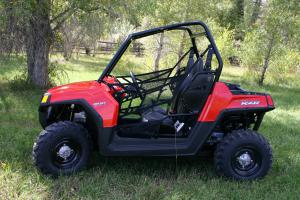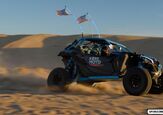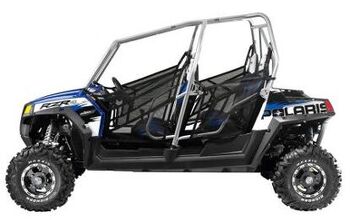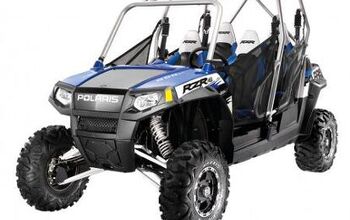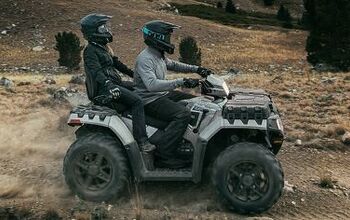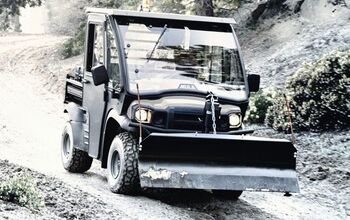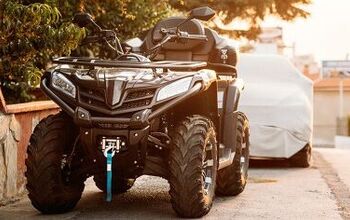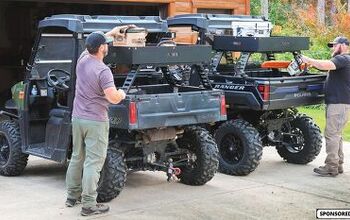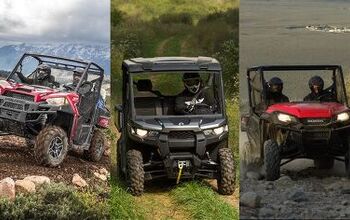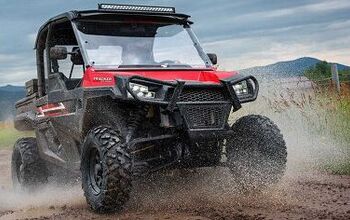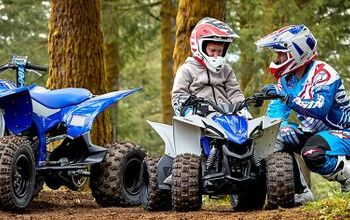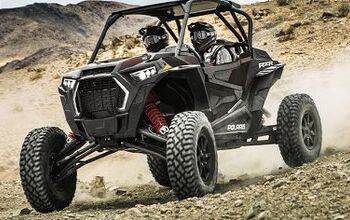2010 Polaris Ranger RZR Review
In November of 2003 the ATV world was turned upside down when Yamaha introduced a new model to its lineup. It was called the Rhino and it wasn’t an ATV, but it wasn’t really a utility vehicle either. Basically it was a combination of an ATV’s agility, a UTV’s capability, and the pure fun of a dune buggy. Yamaha used the term Side-by-Side to classify this new model. With the Rhino, Yamaha started a whole new class of off-roading and from that day on the off-road world would never be the same.
Then in February of 2007 it happened again! This time it was Polaris that was responsible for the upheaval when it introduced a new model that was a whole new Side-by-Side. Called the Ranger RZR, it seemed to fit better into the category of a 2-seat ATV rather than a Side-by-Side like the Rhino because the RZR fit on the 50 inch ATV-only trails.
Polaris did not sit idly by with its RZR. For 2009 the Minnesota-based manufacturer continued the RZR’s development by making a host of evolutionary improvements. First, to improve safety, the protective roll cage was strengthened by 30% and the side safety nets were revised for easier use. Also modified were the shoulder protectors.
2010 Polaris Ranger RZR
One of the most noticeable improvements was the change in the throttle pedal. The early models were plagued with complaints by many of a too-quick throttle response that could cause jerky operation at slow speeds over bumpy terrain. For 2009 the throttle linkage was modified to require a bit more movement for the first portion of throttle application. In addition to that, a heel pocket was added into the floorboard to help keep your foot from sliding around as much in rough terrain.
For 2010 Polaris kept things pretty much the same, but it did give riders a little more oomph by increasing the top speed by 5 mph to 60 mph.
Ergonomics
One of the nicest features of the RZR is that it gives you the ability to adjust the seats fore and aft for a better fit. Although not quite as easy as a sliding lever like you find on your car, you can unlatch the seat from the RZR and by loosening 4 torx-head screws slide the seat forward or back. We do question the use of Torx-heads bolts for the adjustment as we’re not sure how many people carry a set of those around in their toolkit! Fortunately, there’s enough adjustment to the seats to provide a comfortable seating position for just about everyone from 5’ 5” to 6’5”. Also helping in that department is the tilt steering wheel. Simply pull the lever on the side of the steering column and a hydraulic shock allows the wheel to tilt up for easy egress and seating for the big and tall group, and down for easy reach by those in the category of short and thin. The plastic steering wheel has a pair of bulges at 10 and 2 o’clock that help make it more comfortable to grip, even in tough going.
The dash layout and gauges remain the same as it has been, with a large dial speedometer located in the center of the dash with the odometer, trip odometer, hour meter, tachometer, clock, fuel gauge, and drive position all located inside its face. Also on the dash are the switches for the headlights, the all wheel drive system, along with a 12-volt accessory plug. Missing for 2009 is the switch and the rear backup and work lights that switch operated. Evidently few people use their RZRs at night or Polaris saw the elimination as a way to save a few dollars along the assembly line. On the passenger’s side you’ll find the same great adjustable T-handle grab bar that’s typically found only in off-road racecars and sand buggies. Although other manufacturers have tried their best to provide a new and improved way for passengers to comfortably hold on while pounding through the back country, the simple T-handle is still by far the best, easiest to use, and most comfortable. What’s missing is any type of sealed storage in the cabin – except for a small box located under the driver’s seat.
Drivetrain
Throttle and brake pedals are set up like any automatic car or truck.
Powering the RZR is a longitudinal-mounted, liquid-cooled and fuel injected, 760cc Twin cylinder engine putting out 52 horsepower and propelling the RZR to a top speed of approximately 60 mph. There is a lever between the seats to direct the engine’s power through the CVT transmission that’s mounted to the rear of the Twin cylinder engine. Pull the lever all the way back for high range. One notch forward of that is low range, and forward from that is neutral and forward from that is reverse with park position at the very front. For 2009 Polaris has modified the shift linkage for easier shifting between gears, and most importantly the shifter can now be moved more easily from the park position even when the RZR’s parked on a steep incline.
Previous RZRs have been plagued with problems of dust getting through the air filter intake system and causing engine damage so Polaris redesigned the intake system for improved durability. Now the RZR can be driven for many more miles before requiring the air filter be cleaned. Also redesigned is the exhaust system with better heat protection at the exhaust manifold and a redesigned muffler for an even quieter sound.
The brakes are hydraulic-operated discs at each wheel, controlled like your truck by a foot pedal next to throttle. Unfortunately still missing is a good, hand lever operated cable brake system for use as a parking brake or as an emergency brake should the hydraulic brake system fail.
Chassis
Five-way pre-load adjustable shocks are found at each corner.
Polaris strengthened the frame around the front and rear suspension’s attachment points as well as the rear suspension and shock mounts to better withstand the stress from adding long travel arms and shocks on the RZR S model. The front and rear suspensions consist of dual A-arms with 5-way preload adjustable shocks at each corner. Total suspension travel is 9 inches up front and 9.5 inches in the rear.
To help keep the RZR more stable when cornering, you’ll find anti-sway bars on both the front and rear suspensions. Although the anti-sway bars can help on the fast stretches of fire roads, they do limit the articulation of the suspension in the slow-going rough stuff. Although the ground clearance sounds reasonable at 10 inches with the stock 25-inch Maxxis bias-ply tires mounted on 12-inch steel wheels, the 77-inch wheelbase can still cause the RZR to drag its middle over many obstacles an ATV would more easily clear. Remember that even though the RZR is barely any wider than the typical ATV it has over two feet more space between the front and rear wheels!
Utility
At only 945 pounds, the RZR has a comparably light dry weight compared to the other side by sides. Unfortunately that lightweight has been achieved with the extensive use of plastics throughout its construction. Although the RZR’s primarily designed for fun running on the trails, a small bed at the rear is rated to carry 300 pounds. It measures 42 inches by 22 inches, which is more than large enough to carry the supplies for two on a long trip, or even overnight if you pack light enough. The RZR can tow 1500 pounds using the slide-in hitch receiver system, which was reinforced in 2009. The bed is also equipped with Polaris’ unique Lock N Ride cargo latching system.
It may be a sport machine at heart, but the RZR can still haul the goods for a long trip.
Conclusion
Thanks to its 50-inch width, narrow trails are no problem for the RZR.
The RZR has a whole lot going for it. We like the sporty, clean looks and the great handling. Thanks to the 760cc Twin and the RZR’s light weight, it has an amazing amount of power. The engine is both great sounding and yet wonderfully quiet at the same time. Of course to us, one of the best features of the RZR is that it fits on those incredible 50-inch, two-track trails that we keep seeing more and more of around the country. We also appreciate the adjustability of the steering wheel and the seats that help the RZR to be comfortable to ride in for hours at a time without complaint. And of course the great grab bar helps the passenger to feel as comfortable in the rough stuff as the operator.
There are some downsides to the RZR, however. First, we really think it needs a hand-operated cable-actuated brake for parking and emergency use. Also the drive system doesn’t provide the engine’s braking to all four wheels – even when in 4WD, and this causes the RZR to be far more demanding to drive in steep downhill terrain than it should be. We also wish it came stock with more sealed storage that’s easily accessible while seated. And now maybe especially more so because we see the RZR S come with nice wheels and tires, we wish the regular RZR would come with a set of wheels and tires more suited for real-world trail use rather than being left stacked in the garage while you spend hundreds more dollars for a set of good radials.
The bottom line on the RZR is this; if you can only have one vehicle for exploring the scenic back country, especially those incredible ATV-only 50” trails, or playing race car driver in the sand dunes, and maybe even doing some light chores around the farm, then you’re going to have to look pretty hard to find any one single vehicle better and more fun than the RZR.
Comparable Vehicles: Arctic Cat Prowler 1000 H2 EFI XTZ, Kawasaki Teryx 750 FI Sport, Yamaha Rhino 700 Sport Edition
Related Reading
More by ATV.com Staff





